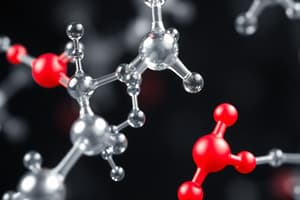Podcast
Questions and Answers
What is the primary function of enzymes in biological systems?
What is the primary function of enzymes in biological systems?
- To provide energy for metabolic reactions
- To regulate the body temperature
- To act as biological catalysts that speed up reactions (correct)
- To store genetic information
Which type of enzyme specificity allows an enzyme to act on a specific isomer only?
Which type of enzyme specificity allows an enzyme to act on a specific isomer only?
- Relative specificity
- Absolute specificity
- Stereo-specificity (correct)
- Structural specificity
What characterizes the allosteric site of an enzyme?
What characterizes the allosteric site of an enzyme?
- It is usually far from the catalytic site and can change enzyme shape (correct)
- It is located at the active site and binds substrates directly
- It only accepts one specific substrate for catalysis
- It is responsible for the enzyme's structural conformation
Which of the following statements best describes dual specificity in enzymes?
Which of the following statements best describes dual specificity in enzymes?
Which type of enzyme specificity is characterized by an enzyme that acts on a particular bond type within a group of compounds?
Which type of enzyme specificity is characterized by an enzyme that acts on a particular bond type within a group of compounds?
What does the Km value signify in enzyme kinetics?
What does the Km value signify in enzyme kinetics?
Which factor does NOT affect the rate of an enzyme-catalyzed reaction?
Which factor does NOT affect the rate of an enzyme-catalyzed reaction?
What characterizes competitive enzyme inhibitors?
What characterizes competitive enzyme inhibitors?
How does temperature affect enzyme activity?
How does temperature affect enzyme activity?
Which of the following statements is true regarding non-competitive enzyme inhibitors?
Which of the following statements is true regarding non-competitive enzyme inhibitors?
Flashcards are hidden until you start studying
Study Notes
Enzymes and Enzyme Systems
- Enzymes are biological catalysts, speeding up biochemical reactions within cells
- Active sites are located in pockets within the enzyme's three-dimensional structure:
- Substrate binding site: where the substrate molecule binds to the enzyme
- Catalytic site: where the catalytic reaction takes place
- Allosteric site: a site where other molecules can bind and influence enzyme activity
- Lock and key model: The substrate fits perfectly into the active site like a key in a lock.
- Induced fit model: The substrate induces a conformational change in the enzyme to fit the substrate.
Substrate Specificity of Enzymes
- Absolute specificity: The enzyme acts on only one substrate (e.g., uricase acting on uric acid).
- Dual specificity: Two types:
- The enzyme acts on two different substrates but catalyzes the same type of reaction (e.g., xanthine oxidase acting on hypoxanthine and xanthine).
- The enzyme acts on one substrate, but catalyzes two different reactions (e.g., isocitrate dehydrogenase acting on isocitrate).
- Stereo-specificity: The enzyme is specific to a specific isomer of a substrate (e.g., L-amino acid oxidase acting on L-amino acids only).
- Relative specificity (group specificity): The enzyme acts on a group of compounds that share the same type of bond (e.g., lipase hydrolyzing ester linkages).
- Structural specificity: The enzyme is specific to a particular bond and the chemical groups around it (e.g., trypsin breaking peptide bonds near arginine or lysine).
Enzyme Kinetics
- Enzyme kinetics: The study of enzyme reaction rates.
- [S]: Substrate concentration
- Vo: Initial velocity of a reaction
- Vmax: Maximal velocity of a reaction
- Km: Michaelis constant, representing the substrate concentration at which the reaction rate is half-maximal.
- Significance of Km: Reflects the enzyme's affinity for its substrate.
Factors Affecting Enzyme Activity
- Temperature: Enzyme activity increases with temperature until an optimal point (typically around 37°C - 40°C).
- pH: Enzymes have an optimal pH range for maximal activity (e.g., 7.4 for most human enzymes).
- Enzyme concentration: Increased enzyme concentration leads to a faster reaction rate.
- Substrate concentration: Increased substrate concentration leads to faster reaction rate up to a point.
- Cofactors and coenzymes: These molecules are often required for enzyme activity and can increase the reaction rate.
- Product concentration: Can inhibit enzyme activity through feedback regulation.
Enzyme Inhibitors
- Competitive inhibitors: Structurally similar to the substrate and bind to the active site, blocking substrate access. Examples: Allopurinol (inhibits xanthine oxidase) and methotrexate (inhibits dihydrofolate reductase).
- Non-competitive inhibitors: Bind to a site other than the active site, altering the enzyme's shape and activity.
Zymogens (Proenzymes)
- Zymogens: Inactive precursor forms of enzymes. They are activated by:
- Release of inhibitory polypeptide by cleavage or conformational change.
- Association with a cofactor (e.g., Mg2+).
- Association with another protein.
- Significance of zymogens: Protects cells and transport systems, allows for storage, and provides regulatory mechanisms.
Isoenzymes (Isozymes)
- Isoenzymes: Multiple forms of the same enzyme with different physical properties.
- Same catalytic activity, but different electrophoretic mobility, inhibitor sensitivity, and tissue distribution.
- Examples: Lactate dehydrogenase (LDH), Creatine kinase (CK), Acid phosphatase (ACP), and Alkaline phosphatase (ALP).
Lactate Dehydrogenase (LDH)
- Catalyzes the conversion of lactate to pyruvate in the presence of NAD+.
- Tetrameric protein, comprised of two subunits (H and M), with five isoenzymes: LDH-1 (H4), LDH-2 (H3M1), LDH-3 (H2M2), LDH-4 (H1M3), and LDH-5 (M4).
- Elevated levels in blood indicate damage to specific organs:
- Myocardial infarction: LDH-1 and LDH-2 predominate.
- Viral hepatitis: LDH-5 and LDH-4 predominate.
- Other diseases: LDH levels can be elevated in a variety of other conditions, including blood diseases and malignancies.
Studying That Suits You
Use AI to generate personalized quizzes and flashcards to suit your learning preferences.



